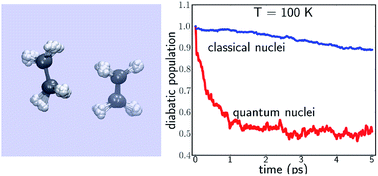Nonadiabatic dynamics with quantum nuclei: simulating charge transfer with ring polymer surface hopping†
Abstract
Investigation of many electronic processes in molecules and materials, such as charge and exciton transport, requires a computational framework that incorporates both non-adiabatic electronic effects and nuclear quantum effects, in particular at low temperatures. We have recently developed an efficient semi-empirical fewest switches surface hopping method, denoted fragment orbital-based surface hopping (FOB-SH), that was tailored towards highly efficient simulation of charge transport in molecular materials, yet with nuclei treated classically. In this work, we extend FOB-SH and include nuclear quantum effects by combining it with ring-polymer molecular dynamics (RPMD) in three different flavours: (i) RPSH with bead approximation (RPSH-BA) as suggested in Shushkov et al., J. Chem. Phys., 2012, 137, 22A549, (ii) a modification of (i) denoted RPSH with weighted bead approximation (RPSH-wBA) and (iii) the isomorphic Hamiltonian method of Tao et al., J. Chem. Phys., 2018, 148, 10237 (SH-RP-iso). We present here applications to hole transfer in a molecular dimer model and analyze detailed balance and internal consistency of all three methods and investigate the temperature and driving force dependence of the hole transfer rate. We find that RPSH-BA strongly underestimates and RPSH-wBA overestimates the exact excited state population, while SH-RP-iso gives satisfactory results. We also find that the latter predicts a flattening of the rate vs. driving force dependence in the Marcus inverted regime at low temperature, as often observed experimentally. Overall, our results suggest that FOB-SH combined with SH-RP-iso is a promising method for including zero point motion and tunneling in charge transport simulations in molecular materials and biological systems.

- This article is part of the themed collection: Quantum effects in complex systems


 Please wait while we load your content...
Please wait while we load your content...